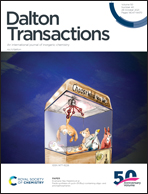Reduction of highly bulky triphenolamine molybdenum nitrido and chloride complexes†
Abstract
Transition metal nitrides are key intermediates in the catalytic reduction of dinitrogen to ammonia. To date, transition metal nitride complexes with the triphenolamine (TPA) ligand have not been reported and the system with the ligand has been much less studied for ammonia formation compared with other systems. Herein, we report a series of molybdenum complexes supported by a sterically demanding TPA ligand, including a nitrido complex N![[triple bond, length as m-dash]](https://www.rsc.org/images/entities/char_e002.gif) Mo(TPA). We achieved the stoichiometric conversion of the nitride moiety into ammonia under ambient conditions by adding proton and electron sources to N
Mo(TPA). We achieved the stoichiometric conversion of the nitride moiety into ammonia under ambient conditions by adding proton and electron sources to N![[triple bond, length as m-dash]](https://www.rsc.org/images/entities/char_e002.gif) Mo(TPA). However, the catalytic turnover for N2 reduction to ammonia was not observed in the triphenolamine ligand system unlike the Schrock system-triamidoamine ligand. Density functional theory calculation revealed that the molybdenum center favors binding NH3 over N2 by 16.9 kcal mol−1 and the structural lability of the trigonal bipyramidal (TBP) molybdenum complex seems to prevent catalytic turnover. Our systematic study showed that the electronegativity and bond length of ancillary ligands determine the preference between N2 and NH3, suggesting a systematic design strategy for improvement.
Mo(TPA). However, the catalytic turnover for N2 reduction to ammonia was not observed in the triphenolamine ligand system unlike the Schrock system-triamidoamine ligand. Density functional theory calculation revealed that the molybdenum center favors binding NH3 over N2 by 16.9 kcal mol−1 and the structural lability of the trigonal bipyramidal (TBP) molybdenum complex seems to prevent catalytic turnover. Our systematic study showed that the electronegativity and bond length of ancillary ligands determine the preference between N2 and NH3, suggesting a systematic design strategy for improvement.



 Please wait while we load your content...
Please wait while we load your content...